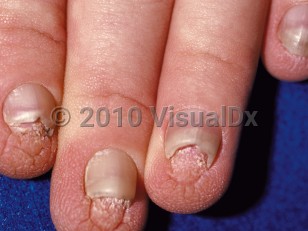Hidrotic ectodermal dysplasia in Infant/Neonate
Alerts and Notices
Important News & Links
Synopsis

Hidrotic ectodermal dysplasia (HED), or Clouston syndrome, is a form of ectodermal dysplasia, a group of approximately 150 genetic disorders characterized by the abnormal development of ectodermal structures including the skin, hair, and nails.
Patients with HED have sparse, fragile hair in childhood and commonly progress to complete alopecia by their teenaged years. Eyebrows, eyelashes, pubic hair, and axillary hair can be affected as well. Hair shaft abnormalities such as trichorrhexis nodosa, pili bifurcati, pili torti, and longitudinal grooves have been reported. Fingernails and toenails appear milky white in infancy and gradually evolve into thickened, cone-shaped nails with distal onycholysis and an increased risk of paronychial infections in adulthood. Patients also frequently exhibit palmoplantar keratoderma, skin hyperpigmentation over the extensor surface of joints, and digital clubbing. In rare cases, patients with HED have been reported to have early-onset cataracts, sensorineural hearing loss, polydactyly / syndactyly, and eccrine syringofibroadenomas. In contrast to hypohidrotic ectodermal dysplasia, patients with HED have normal dentition and the capacity to sweat.
HED is an autosomal dominant disorder caused by mutations in the GJB6 gene, which encodes for the protein connexin 30, a key component of intercellular gap junctions. It is rare; the disease incidence has been estimated to be 1 in 100 000. HED has been reported in diverse populations worldwide but appears to have a higher prevalence in individuals of French-Canadian descent. Male and female patients are equally affected, but the clinical presentation of affected individuals can be highly variable. The life expectancy of affected individuals is normal.
Patients with HED have sparse, fragile hair in childhood and commonly progress to complete alopecia by their teenaged years. Eyebrows, eyelashes, pubic hair, and axillary hair can be affected as well. Hair shaft abnormalities such as trichorrhexis nodosa, pili bifurcati, pili torti, and longitudinal grooves have been reported. Fingernails and toenails appear milky white in infancy and gradually evolve into thickened, cone-shaped nails with distal onycholysis and an increased risk of paronychial infections in adulthood. Patients also frequently exhibit palmoplantar keratoderma, skin hyperpigmentation over the extensor surface of joints, and digital clubbing. In rare cases, patients with HED have been reported to have early-onset cataracts, sensorineural hearing loss, polydactyly / syndactyly, and eccrine syringofibroadenomas. In contrast to hypohidrotic ectodermal dysplasia, patients with HED have normal dentition and the capacity to sweat.
HED is an autosomal dominant disorder caused by mutations in the GJB6 gene, which encodes for the protein connexin 30, a key component of intercellular gap junctions. It is rare; the disease incidence has been estimated to be 1 in 100 000. HED has been reported in diverse populations worldwide but appears to have a higher prevalence in individuals of French-Canadian descent. Male and female patients are equally affected, but the clinical presentation of affected individuals can be highly variable. The life expectancy of affected individuals is normal.
Codes
ICD10CM:
Q82.4 – Ectodermal dysplasia
SNOMEDCT:
54209007 – Hidrotic ectodermal dysplasia
Q82.4 – Ectodermal dysplasia
SNOMEDCT:
54209007 – Hidrotic ectodermal dysplasia
Look For
Subscription Required
Diagnostic Pearls
Subscription Required
Differential Diagnosis & Pitfalls

To perform a comparison, select diagnoses from the classic differential
Subscription Required
Best Tests
Subscription Required
Management Pearls
Subscription Required
Therapy
Subscription Required
References
Subscription Required
Last Reviewed:10/16/2019
Last Updated:12/18/2022
Last Updated:12/18/2022

